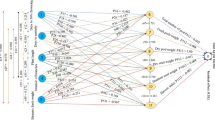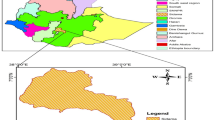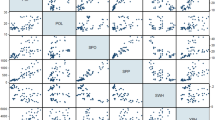Summary
Correlation and path coefficients were calculated for seed yield per plant and its components from 36 clones comprising 8 parental and their 28 single cross clones in Guinea grass (Panicum maximum Jacq.) from data pooled over two years. Seed yield per plant showed significant positive correlation coefficients with branch number per panicle, panicle number per plant, panicle length, branch length, 100 seed weight and day to flower. Path coefficients analysis revealed that panicle number per plant had highest direct effect on seed yield per plant, followed by branch number per panicle, days to flower and 100 seed weight.
Similar content being viewed by others
References
Bogdan, A.V., 1977. Tropical Pasture and Fodder Plants, Longman, London and New York.
Combes, D. & J., Pernes, 1970. Variation dans les nombres chromosomiques du Panicum maximum Jacq. en relation avec le mode de réproduction. C.R. Acad. Sci. Paris 270: 782–785.
Dewey, D.R. & K.H., Lu, 1954. A correlation and path coefficients analysis of crested wheatgrass seed production. Agron. J. 51: 515–518.
Hanna, W.W., J.B., Powell, J.C., Millot & G.W., Burton, 1973. Cytology of obligate sexual plants in Panicum maximum Jacq. and their use in controlled hybrids. Crop Sci. 13: 726–728.
Javier, E.Q., 1970. The flowering habits and mode of reproduction of Guinea grass (Panicum maximum Jacq.). Proceedings of XI International Grassland Congress, Surfers Paradise, Queensland, Australia, pp 284–289.
Savidan, Y.H., 1981. Genetics and utilisation of apomixis for the improvement of Guinea grass (Panicum maximum Jacq.). Proceedings of XIV International Grassland Congress, Lexington, KY, pp 182–184.
Sidhu, B.S., 1976. Annual Report of Forage Section. Animal Science Department, Punjab Agricultural University, Ludhiana.
Sidhu, B.S., B.K. Dhaliwal & R.K. Chowhury, 1987. Embryological studies in Guinea grass. In: K.S. Gill, M.M. Verma & K.S. Bains (Eds.). First Symposium on Crop Improvement, Crop Improvement Society of India, Ludhiana, India, pp 77–78.
Sidhu, B.S., P.D. Mehndiratta & R.K. Batta, 1989. Breeding Guinea grass (Panicum maximum Jacq.) for stall-feeding. Proceedings of XVI International Grassland Congress, Nice, France, pp 325–326.
Smith, R.L., 1971. Sexual reproduction in Panicum maximum Jacq. Crop. Sci. 12: 624–627.
Sukhchain, 1990. Genetic analysis of some quantitative traits in Panicum maximum Jacq., Ph.D. Thesis, Punjab Agricultural University, Ludhiana.
Warmke, H.E., 1954. Apomixis in Panicum maximum. Am. J. Bot. 41: 5–11.
Author information
Authors and Affiliations
Rights and permissions
About this article
Cite this article
Sukhchain, Sidhu, B.S. Correlation and path coefficients analysis for reproductive traits in Guinea grass. Euphytica 60, 57–60 (1992). https://doi.org/10.1007/BF00022258
Received:
Accepted:
Issue Date:
DOI: https://doi.org/10.1007/BF00022258




